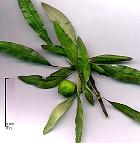Pear tree, Pyrus communis 
This family is characterised by fleshy fruits, with skin and calyx (shriveled remains of the sepals, style and stamens of the flower), containing pips (which are seeds).
 Etymology: from Latin "Pirus", and from Celtic " per ". Etymology: from Latin "Pirus", and from Celtic " per ".
Origin: Middle East.
Habitat : The Pear tree is met in the wild state in woods and hedges.
Hardiness: zone 7 (it supports cold until -17 °C or 1 °F). The Pear tree is less resistant than the apple tree. It is necessary to shelter it from cold winds.
Maximum size : 20 m (the biggest of Malaceae).
Bark shedding in scales ensconced themselves in rectangular, dark brown.
Deciduous foliage. Leaves alternate, oval, smooth, pinked. Stems with prickly tips.
Whitish flowers with anthers roses-purples, which bloom in April, before the appearance of leaves, and are pollinated by the honeybees.
Fruit: 6-8 cm, ripe pear in summer or in winter according to species. Production begins from the 2nd and especially of the 3rd year.
Legends and traditions: in Greek mythology, the pear tree is a lunar tree (perhaps because of its white flowers). It is devoted to Hera, wife of Zeus.
Use: most long-lived fruit tree.
Maintenance: the Pear tree makes, for its production. See advice of pruning.
As most fruit trees, the pear tree is threatened by bacteria, insects and other fungous diseases, as the Scab (Venturia pirina) and Moniliose (Monilia fructigena). Bacterioses is serious: Pseudomonas syringae and the Fire blight (Erwinia amylovora). Among viral infections, the annular Mosaic, the Yellowing of ribs, viral Wilt and Gravel (stony pears) are the most detrimental.
For the treatment, see this page.
Willow-leaf Pear
Origin: Caucasus and Middle East, cultivated as ornamental tree.
Height:6 m tall.
It is characterised by leaves fine and lengthened resembling those of willows, clear underside. At the beginning, they are shaggy silvery. |